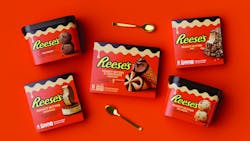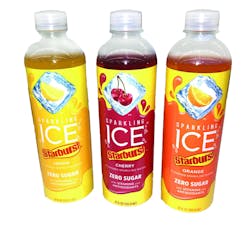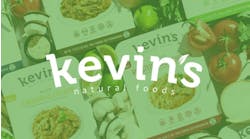Flower City Flavor Co. is not a widely known food manufacturer. In fact, its website encourages customers to visit two local drugstores in Rochester, N.Y., to see its hot sauces, vinegars and olive oil products.
But these days many more potential customers are aware of the firm, at least its Bourbon Barrel Malt Vinegar. That’s because New York Chips, which sells its products at Wegmans, Walmart and Tops Friendly Markets locations in upstate New York, co-branded with Flower City’s Bourbon Barrel Malt Vinegar to create their Salt & Vinegar Chips.
“When the chips first debuted, the sales of my malt vinegar increased 27% in the first month after,” says Chris Whitehair, Flower City Flavor’s owner. “When they started appearing in Wegmans, sales of the malt vinegar increased 34%.
“Malt vinegar is definitely more niche than a wing sauce or BBQ sauce, so I never expected a crazy explosion,” he continues, “but I am very happy with the visibility it brings my brand, since my products are not in those big retailers and these chips now give me the opportunity to say that I am.”
Co-branding – the practice of combining two brands in one product – can significantly boost the visibility and market of both brands. It’s a strategy that is used by food manufacturers of all sizes, from tiny Flower City Flavor Co. to Hershey.
“Cobranding is like cross-pollinating,” says Reilly Newman, brand strategist and founder of Motif Brands. “You are able to leverage existing intellectual assets from one brand and have it complement the other brand. They kind of feed off each other.”
Combined power
The value of co-branding lies in the combined power of the brands involved. In some cases, the brands are clearly complementary – such as Oreo Funfetti Chocolate Cake Mix from Pillsbury, which unites the popular cookie with a well-known cake mix brand – but in other cases the brands unite for a little shock value.
Take the case of Brave Robot ice cream pairing up with Levi’s jeans in 2021. That combination obviously did not involve complementary flavors, but the ice cream brand and apparel brand generated considerable attention when the cobranded Summer Swirl ice cream flavor was introduced.
The combination made sense because both brands are involved with sustainability initiatives, says Rachel Krupa, a branding and public relations expert and founder of The Goods Mart. Brave Robot is a plant-based ice cream that touts its sustainability bona fides and Levi’s identifies itself as focused on “climate, consumption and community.”
“We created a collaborative flavor that was blueberry, strawberry swirl and vanilla ice cream, and did a co-branded ice cream truck in New York outside of the Levi’s stores that drove people to learn about Brave Robot,” Krupa says. “It was mutually beneficial, because Brave Robot got a lot of visibility because of the Levi’s partnership, but also Levi’s got the sustainability side and the new freshness that Brave Robot had.”
Regardless of whether a co-brand collaboration succeeds because it’s complementary or it shocks consumers, it helps companies raise the profile of their brands and extend their reach into new markets.
Consider the Hershey Co., which collaborates on products ranging from Jolly Ranchers-themed New Balance sneakers to Hershey’s Chocolate Porter beer from Yuengling brewery to Reese’s Puffs cereal with General Mills.
“The Hershey Co. recognizes licensing as a strategic lever to brand building,” says Ernie Savo, president of Hershey Licensing Co. “Co-branding opportunities boost Hershey’s brand awareness and consumer engagement, strengthening brand loyalty among our various brands.
“It’s exciting to see shoppers engage with our brands within several top categories of food and general merchandise. Having a large presence in key spaces has allowed Hershey to capitalize on emerging trends, and has enabled Hershey to reach new audiences, leading Hershey to achieve a valuation of $1.9 billion in global licensed retail sales.”
First question: why?
Companies don’t enter into co-branding lightly. There are multiple issues to consider, ranging from finding partners with the right characteristics to deciding how a co-branded product will be perceived by consumers.
Perhaps the first consideration is to decide exactly what a company expects from a co-branding project.
“The first question anyone should ask about a collaboration is, ‘Why?’ ” Krupa explains. “Do you want to get more visibility, more eyeballs, drive sales? Or is this just a brand-building exercise?”
For example, Krupa advised McConnell’s Fine Ice Creams on a cobranding project with Martinelli’s that resulted in McConnell’s Apple Cider & Cranberry Jam flavor ice cream. McConnell’s and Martinelli’s both are long-established, family-owned California companies with similar audience profiles, so they did not necessarily reach a new market with the collaboration. But they did generate buzz.
“Michael Palmer, the owner of McConnell’s, said, ‘Let’s do something that’s great, that’s fun, that’s going to bring eyeballs and add visibility,’ ” Krupa says. “This cobranded ice cream was an elevated version of a regular seasonal flavor and it gives more eyeballs within their scoop shops.”
Krupa adds that the benefit of the partnership extended beyond the immediate sales of the flavor. Consumers may have heard about the collaboration and become more familiar with the brands, or perhaps even visited their respective websites. Whether they bought a pint of Apple Cider & Cranberry Jam ice cream at that point was less important than the long-term benefit of attracting potential buyers.
“It’s not just about the products or the transaction, it’s about someone saying, ‘Hey, I like brand A, and now they’re showing me brand B, so therefore I probably like brand B,’ ” Newman explains. “Psychologically, humans like to be consistent with our internal narrative. So if I’m a big Doritos fan, and then I see this new Jack Link’s-flavored Doritos, I’m biased towards liking that. So Jack Link’s could be introduced to a market segment they weren’t being introduced to before.”
This concept applies to Hershey. Savo says the “why” behind many of the collaborations Hershey undertakes is to grow the company’s exposure in categories in which they do not normally participate.
“We select partners who are well-aligned with the Hershey Co.’s brand portfolio and messaging, and who also have the potential to succeed in their respective domains,” he says. “We choose collaborations that add incremental value to our portfolio, and we focus on building long-term relationships with partners.”
The mechanics
When New York Chips and Flower City Flavor Co. agreed on the Salt & Vinegar chips co-branding project, Whitehair sent bottles of his malt vinegar to his partner. But they didn’t glaze the chips with actual vinegar – they worked with a seasoning company to create powdered seasoning based on the vinegar.
That’s a common approach, since many co-branded products are dissimilar and the primary product just needs the essence of the partner’s product for the co-branding to succeed. In other cases, though, actual product from the secondary partner is incorporated into primary partner’s product.
In the Hershey collaborations, for example, the company making the final product sources chocolate and other ingredients from Hershey Co., Savo explains. This ensures that the finished good has the authentic Hershey flavor profile.
At the other extreme was the collaboration between Brave Robot and Levi’s. Obviously, the Summer Swirl ice cream flavor did not include denim, so there was no exchange of ingredients, but the spirit of the blue jeans brand was present.
Regardless of the level of actual ingredient combinations, successful co-brands require close coordination.
“One company might take the lead more than the other, but it’s very much a collaborative type of process because of the fact that you want everyone to feel part of it,” Krupa says. “You want to make sure that everyone is happy because everyone’s going to be promoting it and getting press on it. So there is a lot of trying and tasting things, making sure people like it, making sure the packaging is great. There is a series of approvals to make sure it meets the brand standards of both companies.”
Savo confirms that Hershey is deeply involved in the co-brands it participates in.
“Hershey is completely immersed within the product development process,” he says. “From the start of the relationship with the partner to when the product debuts in the market, Hershey is involved with the product ideation and its development.”
The money
The financial relationship between the partners in a co-branding project varies. In some cases product is purchased; in other cases licensing fees are paid; and in some cases no money changes hands.
Whitehair reports that he receives a royalty check monthly from New York Chips. He gets a fee for each bag produced, both the standard 8-oz. bags and the individual 1-oz. bags. “I have saved my royalties and will be donating them to Foodlink, a local non-profit,” he notes.
Krupa says that in her experience, sometimes the company that came up with the idea covers the hard costs of the project, such as making the final product, but does not pay a licensing fee. The partner does not earn cash in that case, but benefits from the exposure.
In other cases, however, the differential between the name recognition of the brands may be so great that the lesser brand needs to pay the other for the affiliation. “Sometimes it’s obviously like, ‘Hey, we know you’re going to gain a lot from our name and likeness, so you have to pay us for it,’” she explains.
In the case of a world-famous brand like Hershey, a licensing fee is typical, Savo says.
“When a business chooses to license a brand, there is a licensing fee or royalty involved,” he says. “This allows the business to not only leverage the brand on their packaging and marketing materials, but also benefit from the marketing and brand awareness already associated with a brand such as Hershey.”
Co-branding collaborations emerge from many different situations, but the bottom line is that one company decides it would benefit from an association with another company.
“When one [company] approaches another [about a co-brand project], it’s like, ‘Hey, these are the reasons we feel this is going to be great. Do you agree? Let’s jump on a call and have a conversation,’ ” Krupa says. “I always go into a partnership by saying, ‘Here’s an initial idea,’ but I know that it could morph into something more beautiful by having a collaborative type of conversation with the other brand.”




